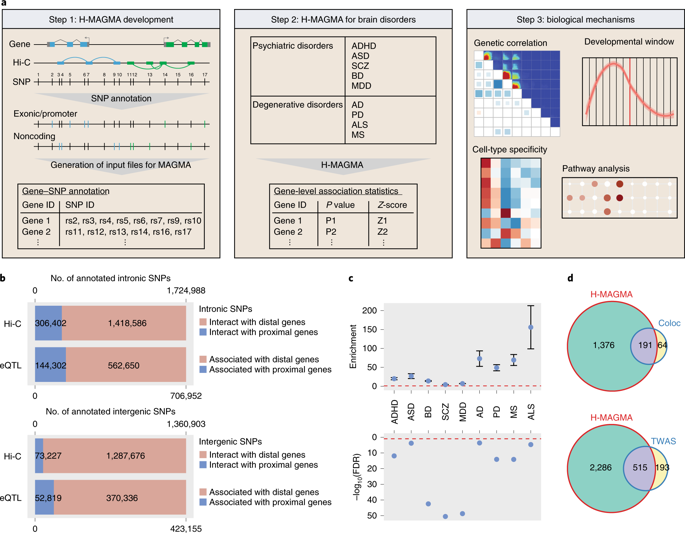当前位置:
X-MOL 学术
›
Nat. Neurosci.
›
论文详情
Our official English website, www.x-mol.net, welcomes your feedback! (Note: you will need to create a separate account there.)
A computational tool (H-MAGMA) for improved prediction of brain-disorder risk genes by incorporating brain chromatin interaction profiles.
Nature Neuroscience ( IF 25.0 ) Pub Date : 2020-03-09 , DOI: 10.1038/s41593-020-0603-0 Nancy Y A Sey 1 , Benxia Hu 1, 2 , Won Mah 1, 2 , Harper Fauni 1 , Jessica Caitlin McAfee 1, 2 , Prashanth Rajarajan 3, 4, 5 , Kristen J Brennand 4, 5, 6, 7 , Schahram Akbarian 5, 7 , Hyejung Won 1, 2
Nature Neuroscience ( IF 25.0 ) Pub Date : 2020-03-09 , DOI: 10.1038/s41593-020-0603-0 Nancy Y A Sey 1 , Benxia Hu 1, 2 , Won Mah 1, 2 , Harper Fauni 1 , Jessica Caitlin McAfee 1, 2 , Prashanth Rajarajan 3, 4, 5 , Kristen J Brennand 4, 5, 6, 7 , Schahram Akbarian 5, 7 , Hyejung Won 1, 2
Affiliation

|
Most risk variants for brain disorders identified by genome-wide association studies reside in the noncoding genome, which makes deciphering biological mechanisms difficult. A commonly used tool, multimarker analysis of genomic annotation (MAGMA), addresses this issue by aggregating single nucleotide polymorphism associations to nearest genes. Here we developed a platform, Hi-C-coupled MAGMA (H-MAGMA), that advances MAGMA by incorporating chromatin interaction profiles from human brain tissue across two developmental epochs and two brain cell types. By analyzing gene regulatory relationships in the disease-relevant tissue, H-MAGMA identified neurobiologically relevant target genes. We applied H-MAGMA to five psychiatric disorders and four neurodegenerative disorders to interrogate biological pathways, developmental windows and cell types implicated for each disorder. Psychiatric-disorder risk genes tended to be expressed during mid-gestation and in excitatory neurons, whereas neurodegenerative-disorder risk genes showed increasing expression over time and more diverse cell-type specificities. H-MAGMA adds to existing analytic frameworks to help identify the neurobiological principles of brain disorders.
中文翻译:

一种计算工具 (H-MAGMA),用于通过合并脑染色质相互作用谱来改进对脑疾病风险基因的预测。
通过全基因组关联研究确定的大多数脑疾病风险变异存在于非编码基因组中,这使得破译生物学机制变得困难。一种常用的工具,基因组注释的多标记分析 (MAGMA),通过将单核苷酸多态性关联到最近的基因来解决这个问题。在这里,我们开发了一个平台,Hi-C 耦合 MAGMA (H-MAGMA),该平台通过将来自人类脑组织的染色质相互作用谱整合到两个发育时期和两种脑细胞类型中来推进 MAGMA。通过分析疾病相关组织中的基因调控关系,H-MAGMA 确定了与神经生物学相关的靶基因。我们将 H-MAGMA 应用于五种精神疾病和四种神经退行性疾病以询问生物学途径,与每种疾病有关的发育窗口和细胞类型。精神疾病风险基因倾向于在妊娠中期和兴奋性神经元中表达,而神经退行性疾病风险基因随着时间的推移表现出增加的表达和更多样化的细胞类型特异性。H-MAGMA 增加了现有的分析框架,以帮助识别脑部疾病的神经生物学原理。
更新日期:2020-03-09
中文翻译:

一种计算工具 (H-MAGMA),用于通过合并脑染色质相互作用谱来改进对脑疾病风险基因的预测。
通过全基因组关联研究确定的大多数脑疾病风险变异存在于非编码基因组中,这使得破译生物学机制变得困难。一种常用的工具,基因组注释的多标记分析 (MAGMA),通过将单核苷酸多态性关联到最近的基因来解决这个问题。在这里,我们开发了一个平台,Hi-C 耦合 MAGMA (H-MAGMA),该平台通过将来自人类脑组织的染色质相互作用谱整合到两个发育时期和两种脑细胞类型中来推进 MAGMA。通过分析疾病相关组织中的基因调控关系,H-MAGMA 确定了与神经生物学相关的靶基因。我们将 H-MAGMA 应用于五种精神疾病和四种神经退行性疾病以询问生物学途径,与每种疾病有关的发育窗口和细胞类型。精神疾病风险基因倾向于在妊娠中期和兴奋性神经元中表达,而神经退行性疾病风险基因随着时间的推移表现出增加的表达和更多样化的细胞类型特异性。H-MAGMA 增加了现有的分析框架,以帮助识别脑部疾病的神经生物学原理。



























 京公网安备 11010802027423号
京公网安备 11010802027423号